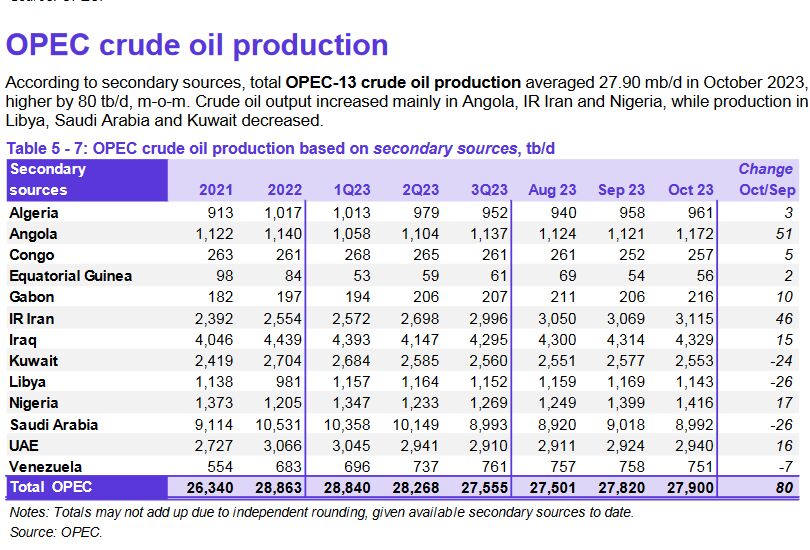According to OPEC’s Monthly Oil Market Report (MOMR) – November 2023, Iran’s crude output hit 3.115 million barrels per day (mbd) in October, showing a 46,000 bpd increase from a month earlier.
The MOMR statistics show Iran retaining its place as the third-largest producer of OPEC, standing after Saudi Arabia with 8.992m bpd output and Iraq with 4.329m bpd production.
According to secondary sources, OPEC crude oil production by its 13 members averaged 27.90m bpd in October 2023, 80,000 bpd higher than its September output. Crude oil output increased mainly in Angola, Iran and Nigeria, while production in Libya, Saudi Arabia, and Kuwait decreased.
Crude oil price movements
In October, the OPEC Reference Basket (ORB) fell by $2.82, or 3.0%, m-o-m, to an average of $91.78/b. The ICE Brent front-month contract fell by $3.89, or 4.2%, m-o-m, to $88.70/b, and the NYMEX WTI front-month contract fell by $3.96, or 4.4%, m-o-m, to average $85.47/b. The DME Oman front-month contract fell by $4.06, or 4.3%, m-o-m, to settle at $89.31/b. The front-month ICE Brent/NYMEX WTI spread widened in October by 7¢ to average $3.23/b. The market structure strengthened further as the front end of futures forward curves for ICE Brent, NYMEX WTI and DME Oman steepened on concerns over geopolitical tensions in the Middle East. Hedge funds and other money managers heavily cut bullish positions, fueling price volatility and contributing to the drop in futures prices.
World oil demand
The world oil demand growth forecast for 2023 is revised up marginally from the previous month’s assessment to 2.5m bpd. Revisions to data for the OECD countries throughout the first three quarters largely offset each other. In the non-OECD, the upward revisions to China’s oil demand in both 3Q23 and 4Q23 outpaced the downward revisions in the non-OECD region in 3Q23. In 2023, OECD oil demand is expected to rise by around 0.1m bpd, while non-OECD oil demand is expected to increase by 2.4m bpd. For 2024, world oil demand is expected to grow by a healthy 2.2m bpd, unchanged from the previous month’s assessment. The OECD is expected to expand by about 0.3m bpd in 2024, with OECD Americas contributing the largest increase. The non-OECD is set to drive next year’s growth, increasing by about 2.0m bpd, with China, the Middle East, Other Asia and India contributing the most.
World oil supply
Non-OPEC liquids supply growth forecast is revised up to 1.8m bpd in 2023. Main drivers of liquids supply growth for 2023 include the U.S., Brazil, Kazakhstan, Norway, Guyana, Mexico and China. For 2024, non-OPEC liquids production is expected to grow by 1.4m bpd, broadly unchanged from the previous month’s assessment.
Main drivers for liquids supply growth next year are set to be the U.S., Canada, Guyana, Brazil, Norway and Kazakhstan. OPEC NGLs and non-conventional liquids are forecast to grow by around 50,000 bpd in 2023 to average 5.4m bpd and by another 65,000 bpd to average 5.5m bpd in 2024. OPEC-13 crude oil production in October increased by 80,000 bpd m-o-m to average 27.90m bpd, according to available secondary sources.
Balance of supply and demand
Demand for OPEC crude in 2023 remained unchanged from the previous month’s assessment to stand at 29.1m bpd, which is 0.6m bpd higher than in 2022. Demand for OPEC crude in 2024 is also remained unchanged from the previous month’s assessment to stand at 29.9m bpd, 0.8m bpd higher than the estimated level in 2023.


Your Comment